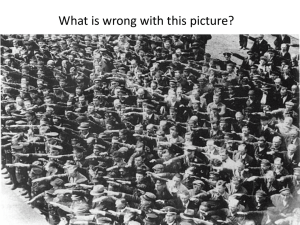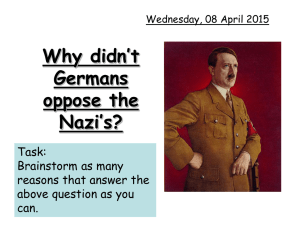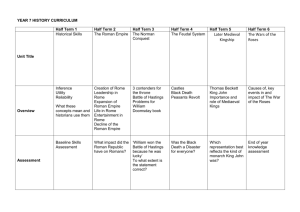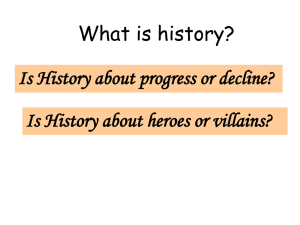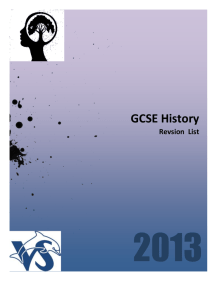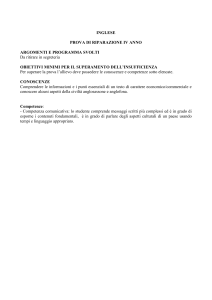S4_Topic_Revision_2
advertisement
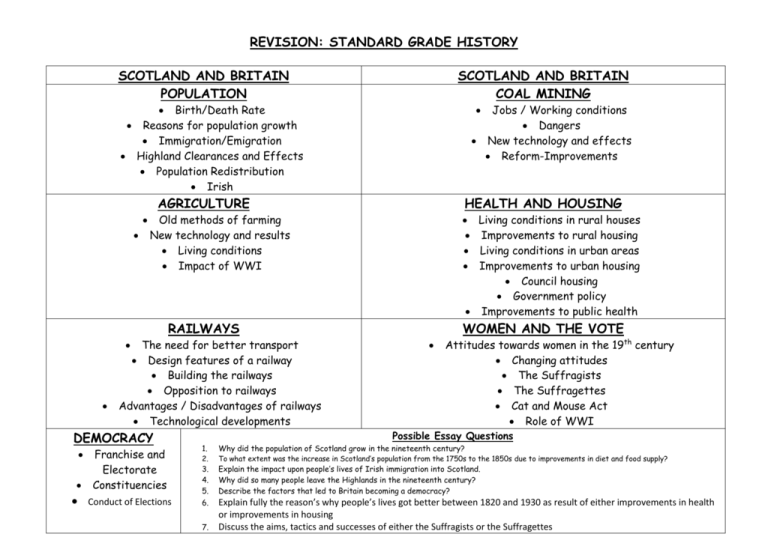
REVISION: STANDARD GRADE HISTORY SCOTLAND AND BRITAIN POPULATION SCOTLAND AND BRITAIN COAL MINING Birth/Death Rate Reasons for population growth Immigration/Emigration Highland Clearances and Effects Population Redistribution Irish Jobs / Working conditions Dangers New technology and effects Reform-Improvements AGRICULTURE HEALTH AND HOUSING Old methods of farming New technology and results Living conditions Impact of WWI Living conditions in rural houses Improvements to rural housing Living conditions in urban areas Improvements to urban housing Council housing Government policy Improvements to public health RAILWAYS The need for better transport Design features of a railway Building the railways Opposition to railways Advantages / Disadvantages of railways Technological developments DEMOCRACY WOMEN AND THE VOTE Attitudes towards women in the 19th century Changing attitudes The Suffragists The Suffragettes Cat and Mouse Act Role of WWI Possible Essay Questions Franchise and Electorate Constituencies 1. Why did the population of Scotland grow in the nineteenth century? 3. 4. 5. Explain the impact upon people’s lives of Irish immigration into Scotland. Why did so many people leave the Highlands in the nineteenth century? Describe the factors that led to Britain becoming a democracy? Conduct of Elections 6. Explain fully the reason’s why people’s lives got better between 1820 and 1930 as result of either improvements in health or improvements in housing Discuss the aims, tactics and successes of either the Suffragists or the Suffragettes 2. 7. To what extent was the increase in Scotland’s population from the 1750s to the 1850s due to improvements in diet and food supply? REVISION: STANDARD GRADE HISTORY WORLD WAR ONE CAUSES Militarism- Naval Arms Race Alliances- Triple Entente/ Triple Alliance Imperialism - Morocco Nationalism - Balkans Sarajevo HOME FRONT WORLD WAR ONE TRENCHES Schlieffen Plan Design Conditions Daily Routine Battles- Passchendaele, Cambrai, Somme Weapons and Effectiveness TREATY OF VERSAILLES Rationing Propaganda DORA Conscription Home Front Germany Big 3 Terms British Reaction German Reaction LEAGUE OF NATIONS Possible Essay Questions Aims Organisation Membership Successes Failures 1. How important as a cause of the First World War was either the naval arms race, the alliance system, conflict over Morocco and rivalry in the Balkans. 2. How far do you agree that during WWI, the difficulty of food supply was the most important problem faced by civilians in Britain? 3. How far do you agree that during the First World War, the difficulty of food supply was the most important problem faced by either civilians in Britain or civilians in Germany 4. In the Allied victory over Germany by 1918, how important was either the Allied use of new technology or the collapse of the German Home Front? REVISION: STANDARD GRADE HISTORY GERMANY The Rise of the Nazis Background - Impact of World War One/Problems facing Germany, Abdication of the Kaiser, From Empire to Republic, Ebert-Groener Pact Political Problems – Constitution, Fundamental Laws, Spartacist Revolt, Munich Putsch, Kapp Putsch Treaty of Versailles – Leaders, Terms, Reactions Economic Problems –Impact of WWI, Reparations, Invasion of the Ruhr, Hyperinflation, 1924-1929 Stresemann, Dawes Plan Young Plan, Wall Street Crash Appeal of the Nazis – Hitler, Propaganda, Nationalism, Hitler’s Promises, Militarism Possible Essay Questions 1. How far was the Nazi rise to power in January 1933 due to either discontent with the Weimar Republic or the appeal of Hitler and the Nazis? 2. Explain the effects of Nazi policies between 1933 and 1939 towards either young people or Jewish people 3. How far would you agree that the main reason that opposition groups in Nazi Germany failed was either the weaknesses of the opposition groups or the powers of the Nazi state? GERMANY Maintaining Power in Nazi Germany Background – Nazi Steps to Power – Reichstag Fire, Enabling Act, Night of the Long Knives, Death of Hindenburg Negative Policies (Stick) – Role of SS/ Gestapo, Dissolution of Political Parties and Trade Unions, Role of the Youth (Education and Youth Organisations), Persecution of the Jews (Nuremberg Laws, Kristallnacht etc), Treatment of the Churches, Role of media and Propaganda, Crushing the opposition (Meuten, Edelweiss Pirates, Swing Kids, White Rose Group etc) Positive Policies (Carrot) – Unemployment, Strength Through Joy, National Labour Front etc REVISION: STANDARD GRADE HISTORY GENERAL KU Use as much information from the source as you can MAKE SURE YOU ALSO ADD IN RECALL CREDIT KU ‘How important’ question – Make sure you describe the factor it asks about and then also give evidence about other factors that are also important ‘Explain why’ question – Do not just list information. Make sure you are using information to explain why something occurred ‘Describe’ question – Give as much detail as you can HOW USEFUL Purpose- to describe / persuade / explain Author – say something about them – expert / eyewitness / historian / person of authority ( make sure you say what they are an eye-witness to / what they are an expert on etc) Content – 2 or 3 sentences with good information from the source Limitation – is it only one city? / one point of view? / what is not mentioned in the source? Accuracy – accurate as it agrees with your knowledge – you must put what your knowledge is Date – “primary source written in 1915 at the time that men were fighting in the trenches”/ secondary source “written after the time…” BALANCED CONCLUSION ( only in Scot and Brit) Will always ask “How far do you agree...” Sources – Use the information from the question before (What Evidence) Give BOTH sides of the issue Recall - Give BOTH sides of the issue Conclusion – Give BOTH sides of the issue COMPARISON Write a sentence on what they agree/disagree on Source A says… Source B says… 5 marks - write down evidence that only 1 source mentions ATTITUDE OF AUTHOR What EMOTIONS are there in the source? How does the author FEEL about the topic? Use evidence from the source to back up the emotion HOW FULLY “How much” question – Use source and recall The answer will always be that the source does tell you things BUT there is missing information Remember to include “However, the source does not say that...” REVISION: STANDARD GRADE HISTORY REVISION: STANDARD GRADE HISTORY
